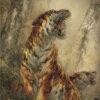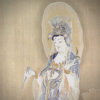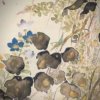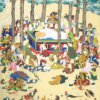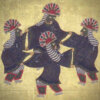Kodama Katei: A Literati Painter Who Loved Nagano
Kaki Reimō Gyokudōfuki Sōhaku Heiankyō (Two Meadow Buntings Praying for Peace with Peonies, Magnolias, and Crabapple Trees)

Kodama Katei was born in Nagano prefecture in 1841. Losing his father at the age of 12, he studied under Sakuma Unsō, a painter from the Nanpin school, and also learned Zen from Azegami Baisen. When his house was burned down by a fire in his village, Katei was left with no other option but to leave the prefecture to wander around various places. During this time, he reunited with Baisen in Odawara and then headed for Tokyo, where he studied under Tanomura Chokunyū. In 1889, when he was 40 years old, he returned to his hometown and entered a life of indulging in painting. Hereafter, he never once left the place for the remaining 33 years of his life. He exhibited a masterpiece at the first Tōyō Kaiga Kyōshinkai Exhibition in 1886, where he was awarded a silver prize, but despite his rise to fame, Katei remained indifferent to it and refused any endorsements to be recommended as an Imperial Household Artist. He lost his home once again due to a landslide in 1896, and despite struggling from extreme poverty, continued to focus on his creations. He died in 1913, at the age of 73. His painting style consists of a combination of styles from various schools, notably the style of Ming-Qing paintings. In this way, Katei opened up his own distinctive approach to the Meiji period’s Nanga paintings, and his works are highly regarded for their virtuous and refreshing qualities.
This painting is from 1911, when Katei was 71 years old. ‘Gyokudōfuki’ is a common art motif in nanga paintings along with the ‘Three Friends of Winter (comprised of pine, bamboo, and plum.)’ ‘Fuki’ is another word for peonies, ‘gyoku’ is for magnolias, and ‘dō’ is for crabapple trees — the art motif consists of portraying the three flowers in one painting. Katei furthermore places bamboos, plants that never break no matter how strong the wind, with the peonies, and therefore adds another art motif, ‘Fūki Heian,’ meaning ‘prosperity and peace.’ The painting also includes two little birds that are most likely meadow buntings. Katei was perhaps fond of this motif as there are other works similar to this style. In any case, this spring garden in which the little birds play in, painted with Katei’s skilled brushstrokes and fresh colors, seems as if it is a utopia that was only manifested by Katei, who was a painter that separated himself from the turbulent world and lived high in the mountains.

